Lenz Press
Lenz Press
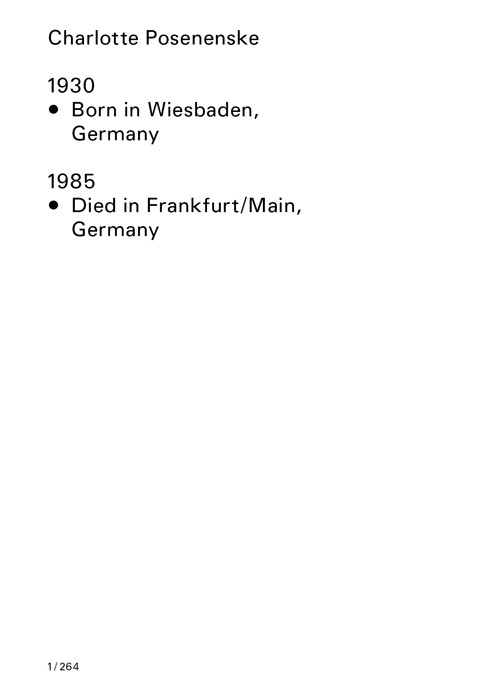
Installation Views
Conceived as a visual résumé, Installation Views provides both a comprehensive overview of Charlotte Posenenske's solo exhibitions and a record of her numerous group shows.
In her Manifesto, Charlotte Posenenske stated: "I find it difficult to come to terms with the fact that art can contribute nothing to the solution of pressing social problems."
Developing her artistic practice throughout the 1960s, Posenenske produced a body of work that uniquely combined several strands of the art of the period: conceptualism, minimalism, and socially engaged participatory art. Her Manifesto, published in Art International in May 1968, lays out the social demands on art as well as the impossibility of fulfilling those demands. Shortly after its publication, Posenenske left the art world behind to pursue her studies in sociology, undertaking a new career in that field.
Conceived as a visual résumé, Installation Views provides both a comprehensive overview of Charlotte Posenenske's solo exhibitions and a record of her numerous group shows. The book features an essay written by curator Erlend Hammer on the role of documentary photographs in the circulation of works of art.
The book was published in conjunction with the eponymous show at the Haugar Art Museum in Tønsberg, Norway—the first full-scale presentation of the artist's oeuvre in Scandinavia. The exhibition showcased works from all the artist's major series of modular sculpture. Consisting of works made over the course of less than 12 months, between 1967 and 1968, preceding the abrupt end to Posenenske's career as an artist, the exhibition had the character of a snapshot. We are left wondering whether her withdrawal from the art world was a logical or necessary consequence of the development of the series. What are we to do with Posenenske's assertion that art is powerless to effectively change society for the better?

Antonio Obá: Rituals of Care
Antonio Obá: Rituals of Care traces the practice of the Brazilian artist since 2016, offering a broad survey of his recent work, dwelling on the recurring motifs and iconographic sources that feed the complex imagery of his painting. Extensively illustrated, the book returns the richness of Obá's paintings, with enlargements on some of the details woven into the pictorial texture that, in addition to showing his masterful technique, make certain elements of his visual vocabulary stand out.
The conversation between Andrea Bellini and Antonio Obá that opens the book offers the opportunity to learn, through the artist's voice, about the key passages of his research, and to examine his diverse cultural references—from the Baroque of Minas Gerais to traditional Chinese painting, from Rembrandt to the Catholic ex-votos—until we discover the Obá's civic vocation, of painting as a spiritual practice.
The two essays commissioned for the occasion analyze the complexity of these layered signifiers. Lorraine Mendes's essay "Every Boy Is a King" offers an in-depth analysis of Obá's religious syncretism. It suggests an interpretation of its layered symbols, particularly the sankofa and the deity Exú, both of which pay tribute to the artist's West African roots. Above and beyond the specific cultural contexts of this iconography, the author emphasizes the universal value of Obá's work, its evocative, transformative, dynamic power, which—like music or dance—knows no national boundaries or barriers.
Larry Ossei-Mensah's essay "Embodiment: The Art of Antonio Obá" investigates the complex cultural legacy that is intertwined with the artist's practice, connected to his Afro-Brazilian roots, to the social and political realities of the Black diaspora, and to Christian, Candomblé, and Umbanda traditions. In addition to examining the context in which Obá's work is rooted, the author situates it within a galaxy of artists who have focused on questions of identity, often using their own bodies as tools of social and cultural critique.
Completing the book is a chronology, compiled by Sara De Chiara, tracing the artist's formative years and exhibition history, accompanied by rich documentary materials.
Published on the occasion of Antonio Obá: Rituals of Care, the first mid-career survey in Europe dedicated to the Brazilian artist, curated by Andrea Bellini, at the Centre d'Art Contemporain Genève, in 2025.
Antonio Obá (born 1983 in Ceilândia, Brazil) lives and works in Brasília. His multifaceted practice encompasses painting, sculpture, photography, installation, video, and performance. His œuvre interrogates and subverts historical representations, reappropriating spiritual practices and stigmas of racism. Obá endeavors to reclaim his African heritage in a societal framework that has historically sought to dilute Black culture. His works therefore confront the violence inflicted over centuries upon African-Brazilian traditions and communities with new narratives.
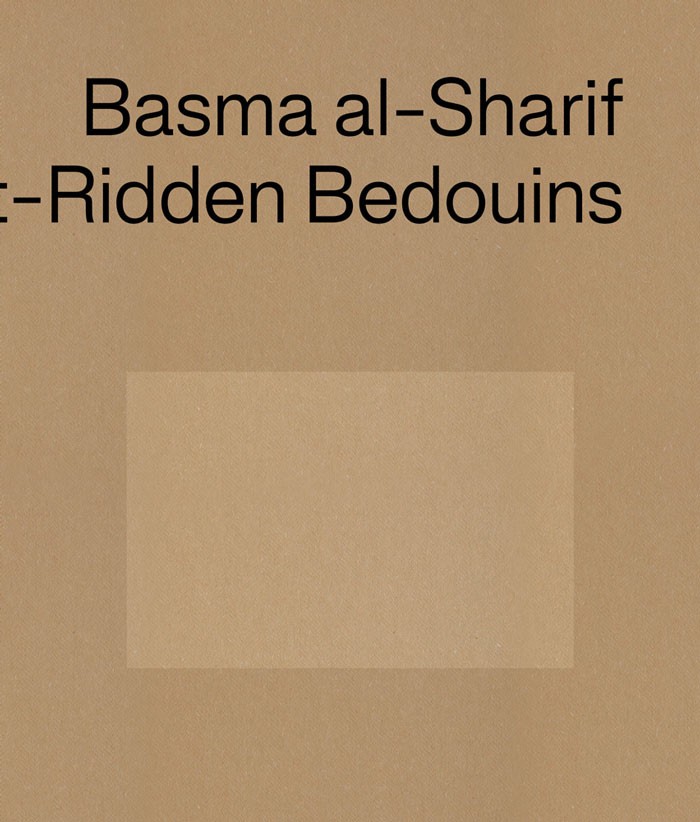
Semi-Nomadic Debt-Ridden Bedouins
Semi-Nomadic Debt-Ridden Bedouins offers an in-depth look at nearly two decades of artistic output by the Palestinian artist and filmmaker Basma al-Sharif. Retracing her practice from recent works back to her earliest experiments, the book provides an original overview of how her visual language and conceptual concerns have evolved over time.
Basma al-Sharif's films and installations navigate the unstable terrains of displacement, colonialism, and representation—often shaped by the ongoing reality of the occupation of Palestine. Through a rich selection of images and curatorial essays, the monograph highlights the layered political and cinematic frameworks within which her works are embedded.
Also included are two newly commissioned literary contributions: a fictional piece by Karim Kattan that resonates with the themes of place and estrangement, and a conversation between al-Sharif and the artist Diego Marcon, in which they reflect on shared affinities, artistic processes, and their long-standing dialogue. Blurring the personal and the political, the real and the imagined, Semi-Nomadic Debt-Ridden Bedouins captures the complexity and urgency of al-Sharif's artistic journey.
Texts by Basma al-Sharif, Karim Kattan, Diego Marcon, et al.
Basma al-Sharif (born 1983 in Koweit) is a Palestinian artist working in cinema and installation. She developed her practice nomadically between the Middle East, Europe, and North America and is currently based in Berlin. Her practice looks at cyclical political conflicts and confronts the legacy of colonialism through satirical, immersive, and lyrical works.
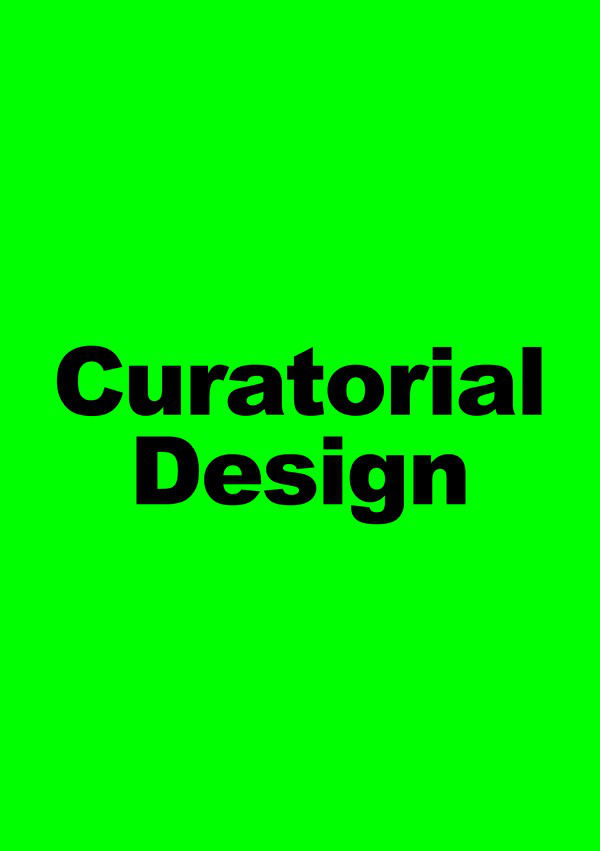
Curatorial Design – A Place Between
Wilfried Kuehn, Dubravka Sekulić
The future of architecture lies in the curatorial approach. This is the thesis put forward by architect Wilfried Kuehn and theorist Dubravka Sekulić in their book Curatorial Design: A Place Between, which brings together contributions from more than 30 authors working in the fields of architecture, art, and curatorial knowledge and practice.
Architectural design and the curatorial share a non-disciplinary background, and aim to assemble diverse forms of knowledge rather than specializing. Inherently transdisciplinary, then, they are at odds with the increasing division of labor in all fields of knowledge and practice. In the face of professionalization, which limits our capacity to intervene comprehensively, design and the curatorial challenge specialization and produce relational knowledge. They intend to create an in-between place, as together they form a novel practice that—in combining heterogenous forms of knowledge—takes center stage rather than serving as a moderator or mediator of sorts. What unites them is the assertion of a relational form, the autonomy of which consists precisely in teasing out relations between different elements. What happens to architectural design when it consciously enters a relationship with the curatorial?
The book is aimed at practitioners and educators in the field of architecture and design, as well as curators and exhibition makers. It contains three photo series by Armin Linke that accompany the three sections of the book: "Public School for Architecture", "Total Reconstruction," and "Designing for Co-Habitation."
Contributions by Martina Abri, Ross Exo Adams, Thomas Auer, Giovana Borasi, Susana Caló, Brendon Carlin, Peggy Deamer, Clémentine Deliss, FICTILIS, Francesco Garutti, Maria Shéhérazade Giudici, Joyce Hwang, Anousheh Kehar, Bettina Köhler, Elke Krasny, Wilfried Kuehn, Ippolito Pestellini Laparelli, Maxim Larrivée, Matthew Leander Kalil, Mark Lee, Steve Lyons for Not An Alternative, Armin Linke, Mona Mahall, Charlotte Malterre-Barthes, Dejan Marković, Ana Miljački, Erica Petrillo, Christian Raabe, Albert Refiti, Damon Rich, Christiane Salge, Ivonne Santoyo-Orozco, Anna Schäffler, Bernd Scherer, Laila Seewang, Dubravka Sekulić, Asli Serbest, Stuart Smith, Laurent Stalder, Milica Tomić.
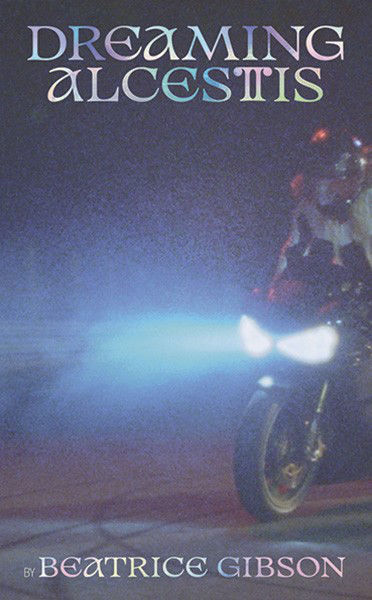
Dreaming Alcestis
Dreaming Alcestis is an artist's book by artist and filmmaker Beatrice Gibson, conceived as an accompaniment to her holographic film installation of the same name. Dreaming Alcestis was co-directed and co-scripted by Gibson, her partner Nicholas Gordon and critic Maria Nadotti. The publication features a specially commissioned essay by poet and translator Allison Grimaldi Donahue, as well as a reprint of the American poet Alice Notley's 1991 essay What Can Be Learned From Dreams?
Drawing on the protagonist of Euripides's ancient myth as its ancestral guide, Dreaming Alcestis offers a poetic reflection on living and dying at a time of acute social, political and economic turmoil, documenting—via dream life—Gibson and Gordon's relocation from Northern to Southern Europe. In the film, two characters, dreaming of a long-dead queen, are filmed in long takes, refracted holographically and interrupted only by the sounds of the city and the sea. In Gibson's words, "2,500 years after her birth, Alcestis—in the film, a mysterious, Lynchian figure—returns from the underworld, dreaming of, or possibly dreamed by, a man and woman who have traversed Europe in search of her, from North to South, with family in tow. Meanwhile, the ice caps melt, 43 wars rage around the globe and another city burns on TV." In a feminist key, Gibson, Gordon and Nadotti reclaim a minor heroine from Greek mythology, using her as a therapeutic device to reflect on what it is to be human in the contemporary context.
Premiering at the British Art show in 2022, Dreaming Alcestis was exhibited on the occasion of the artist's first solo show in Italy, Dream Gossip, at Ordet in Milan, and was subsequently taken on tour, first to the Museo Civico di Castelbuono and then to Macro, the Museum of Contemporary Art in Rome. The book and the film Dreaming Alcestis are part of Alkestis, a project orchestrated by the Museo Civico di Castelbuono in partnership with the British Art Show 9 (Hayward Gallery Touring, Southbank Centre, London).
Edited by Laura Barreca, Edoardo Bonaspetti, Beatrice Gibson.
Texts by Laura Barreca, Edoardo Bonaspetti, Allison Grimaldi Donahue, Alice Notley.
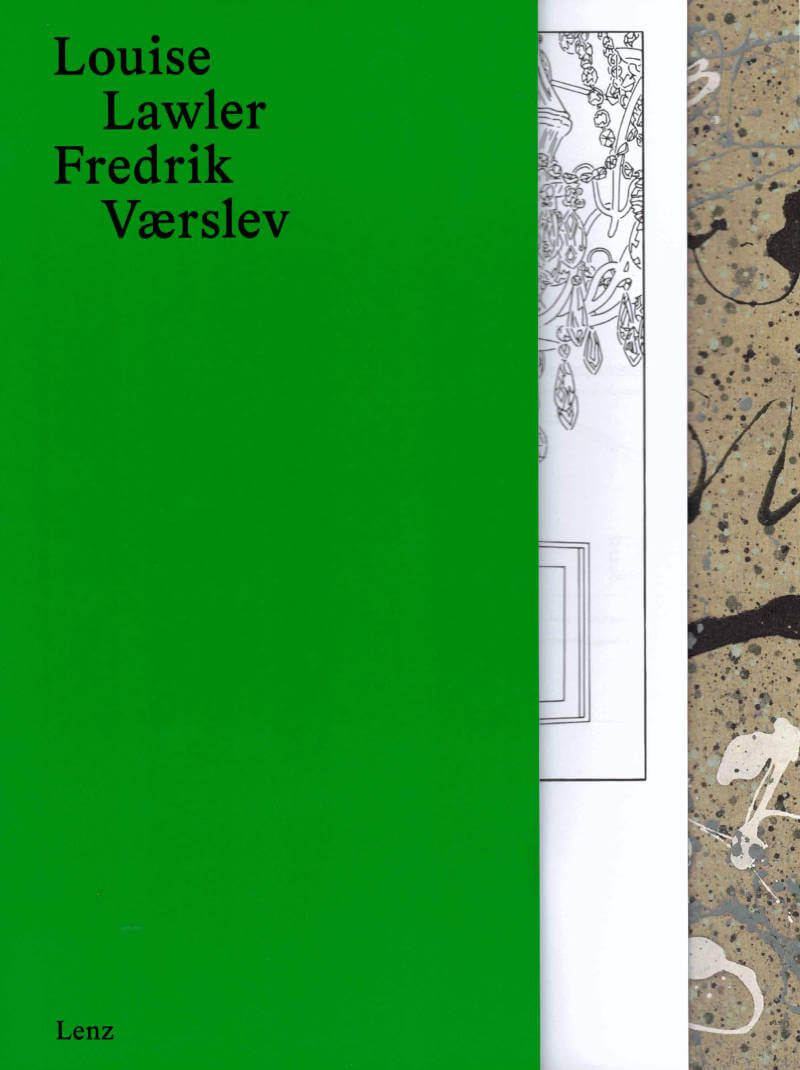
Louise Lawler, Fredrik Værslev
Conceived as a catalogue and an artist's book, the publication offers a deeper insight into the eponymous 2022 exhibition staged at Indipendenza Roma, and explores tensions that can be generated between artworks and their surrounding architectural context, raising questions of taste, value, function and decoration.

Euforia
This monograph explores the work and the artistic activities of Italian radical performer, poet, visual artist and feminist Tomaso Binga through a specific lexicon (Agora, Biographies, the Corporeal Nature of the Word, Correspondences, Geographies, Vaginal Value), and also features a selection of poems by the artist.
The volume explores the key passages of Tomaso Binga's artistic practice, and as such is divided into three macro areas. The first, purely textual, following institutional introduction by the President of the Fondazione Donnaregina per le arti contemporanee Angela Tecce, features texts by Eva Fabbris, Daria Khan, Quinn Latimer, Lilou Vidal, and Stefania Zuliani, as well as a conversation between the artist herself and Luca Lo Pinto. The second part brings together a series of short critical texts that offer an in-depth analysis of single works and small bodies of work by Tomaso Binga. These contents are further subdivided into six categories (Agora, Biographies, The Body of the Word, Correspondences, Geographies, Vaginal Value) with the aim of delving into the key areas of interest in Tomaso Binga's practice in chronological order. Critical contributions are thus provided by Marc Bembekoff, Barbara Casavecchia, Martina Cavalli, Chiara Costa, Anna Cuomo, Valérie Da Costa, Allison Grimaldi Donahue, Daria Khan, Émilie Notéris, Raffaella Perna, Antonello Tolve, and Andrea Viliani. The third and final part is dedicated to the artist's visual poems. Each poem is accompanied by an English translation, in several cases published here for the first time.
Embedded in the language of visual and sound poetry, the practice of Tomaso Binga (Bianca Pucciarelli Menna, born 1931 in Salerno) is based on an ironic, insightful questioning of the idea of gender. In her work, this theme is not only a generator of identity, but also a way of looking afresh at the social roles, rights and opportunities traditionally available to women. Her decision to work under a male pseudonym from 1971 onwards was intended to parody male privilege and to provoke a barbed reflection on the political dimension of what it is to be a woman. Her attitude has served as a key marker within the gender equality issues at the center of the debate raging amongst the younger generations.
Edited by Eva Fabbris, Lilou Vidal, Stefania Zuliani with Anna Cuomo.
Texts by Tomaso Binga, Eva Fabbris, Daria Khan, Quinn Latimer, Luca Lo Pinto, Lilou Vidal, Stefania Zuliani.

Sweat Shame Etc.
Across objects, writing, sound and choreography, British artist Cally Spooner addresses the manners in which specific technological and financial conditions shape and organize life. This volume surveys her artistic output of the last five years.
Sweat Shame Etc. includes a lecture by Spooner along newly commissioned essays by Laura McLean Ferris, Pierre Bal-Blanc, and Lucrezia Calabrò Visconti. A 2018 series of drawings on paper, from which the monograph takes its name, features hastily sketched figures that take care of their bodies while shedding clothes, socks, limbs, and torsos. Though their heads are scratched out, they remain unexpectedly determined and unperturbed.
Published following the eponymous exhibition at the Swiss Institute, New York, in 2018-2019.
Cally Spooner (born 1983 in Ascot, UK, lives and works in London and Turin) is an artist who exhibits performances that unfold across media—on film, in text, as objects, through sound, and as illustrated in drawings.
Edited by Alison Coplan and Laura McLean-Ferris.
Texts by Pierre Bal-Blanc, Lucrezia Calabrò Visconti, Laura McLean-Ferris, Cally Spooner.

Metal Works
A complete survey of the cast, forged, and fabricated metal sculptures made by Danish artist Sidsel Meineche Hansen since 2017.
The artist's practice addresses the industrial complex of virtual and robotic bodies and their relationship to labor in tech, pornography and gaming. While some sculptures were conceived as individual pieces, others were created with digital counterparts within installations that typically include CGI animation, documentary video, drawing and prints.
By presenting the metal works as stand-alone pieces, this book adheres to Meineche Hansen's concern with the material means of production, highlighting their concrete yet elusive nature. Several pieces in the publication are accompanied by poems written by artist Diego Marcon in response to the works. As an artist's project and an archival document, the publication echoes the tradition of documentary photography devoted to sculpture.
Sidsel Meineche Hansen (born 1981 in Denmark, lives and works in London) is a Danish artist. She produces exhibitions, interdisciplinary seminars and publications that foreground the body and its industrial complex, in what she refers to as a "techno-somatic variant of institutional critique". Meineche Hansen questions the body in the field of industrial representations: robotic or virtual bodies, and their relationship with the working world of industries of gaming, pornography, and new technologies. Her research-led practice has taken the form of woodcut prints, sculptures and CGI animations, often made by combining her own low-tech manual craft with outsourced, skilled digital labour.
Edited by Fredi Fischli and Niels Olsen.
Poems by Diego Marcon.

A User's Manual to Claire Fontaine
In the first monograph on the feminist conceptual artist collective Claire Fontaine, political theorist and somatic practitioner Anita Chari explores the artist's theoretical and political innovations to illuminate a more haptic, embodied approach to the practice of critical theory.
A User's Manual to Claire Fontaine explores the work of the feminist conceptual artist collective Claire Fontaine through the lens of her theoretical and political innovations, both inside and outside the context of contemporary art. Theorizing the ways in which Claire Fontaine's experimental approach can illuminate a more haptic, embodied practice of critical theory, this book delineates a series of theoretical techniques and procedures at the core of the artist's work, among them defunctionalization, Institutional Critique, human strike, tactile mimesis, desubjectivation, détournement, magic materialism, and feminist materialism.
Political theorist and somatic practitioner Anita Chari illuminates a larger field of practice for those working within the world of critical theory with this "user's manual" that seeks to reinvest theory with use value, drawing on the resources of critical contemporary art to engage with critical theory in ways that can become embodied, sensate, and tactile, and thus inform contemporary political practices.
"Fluently traversing critical theory, political philosophy, and artistic discourse, this is a brilliant, engaging book on the art and writings of Claire Fontaine—'readymade artist' and conceptual provocateur—as well as a vital elucidation of paths toward a transformative mode of living in the present. Writing with and through rather than, as usual, 'on' her subject, Chari provides her readers with a 'how-to' manual to Claire Fontaine's practice, finding in it a model for embodied resistance."—Tom McDonough, author of The Beautiful Language of My Century
Anita Chari is a political theorist and writer based in Portland, Oregon and is Associate Professor of Political Science at the University of Oregon. Her work explores the significance of aesthetics, artistic practices, and embodiment for critical theory and practice.
Claire Fontaine is a feminist, conceptual artist, founded in Paris in 2004.

Vogliamo Tutto – Cultural Practices and Labor
Nicola Ricciardi, Samuele Piazza
Vogliamo Tutto. Cultural Practices and Labor has its origin in the novel Vogliamo tutto (1971) by Nanni Balestrini, whose protagonist Alfonso Natella became the voice of an entire generation as well as the workers' movements in 1968 Turin. In 2021, thirteen artists were invited to reflect on the change of labor in the contemporary context.
The result is a sum of choral voices and practices, which together outline the peculiar transformative nature of labor and its socio-cultural context over a wide time span: from the impact of the Industrial Revolution to the post-industrial decline and the shifts of the digital era.
The book features two essays by Samuele Piazza and Nicola Ricciardi, curators of the eponymous exhibition at OGR Torino; new writing by the artists Claire Fontaine and Tyler Coburn; and archive texts selected by the artists in the show: Andrea Bowers, Pablo Bronstein, Claire Fontaine, Tyler Coburn, Jeremy Deller, Kevin Jerome Everson, LaToya Ruby Frazier, Elisa Giardina Papa, Liz Magic Laser, Adam Linder, Sidsel Meineche Hansen, Mike Nelson, and Renate Wiehager for Charlotte Posenenske.
The archive texts include the essays "Automation and the Invisible Service Function" by Neda Atanasoski and Kalindi Vora; "Audio Poverty"Diedrich Diederichsen; "Sabotage" by Elizabeth Gurley Flynn; "Wages Against Housework" by Silvia Federici; "The Wreck of the Sea-Venture" by Peter Linebaugh and Marcus Rediker; "Charlotte Posenenske Mimetic Minimalism and Practicability" by Renate Wiehager; an excerpted texts from The Human Animal by Émile Zola; as well as the articles "A Game Designer's Analysis of QAnon" by Reed Berkowitz; "Manage Your Energy, Not Your Time" by Tony Schwartz and Catherine McCarthy; the "Letter of Protest, Frieze Art Fair, New York" by Andrea Bowers, and the "License Agreement" by the Cultural Capital Cooperative collective; the script from Erie by Kevin Jerome Everson; a conversation between David Green and Rick Smith, UAW Local 1112, and LaToya Ruby Frazier.
Contributions from Samuele Piazza, Nicola Ricciardi, Tyler Coburn, Claire Fontaine.
Reprinted archive texts by Neda Atanasoski & Kalindi Vora, Diedrich Diederichsen, Silvia Federici, Peter Linebaugh & Marcus Rediker, Renate Wiehager, Reed Berkowitz, Tony Schwartz & Catherine McCarthy, Andrea Bowers, the Cultural Capital Cooperative.
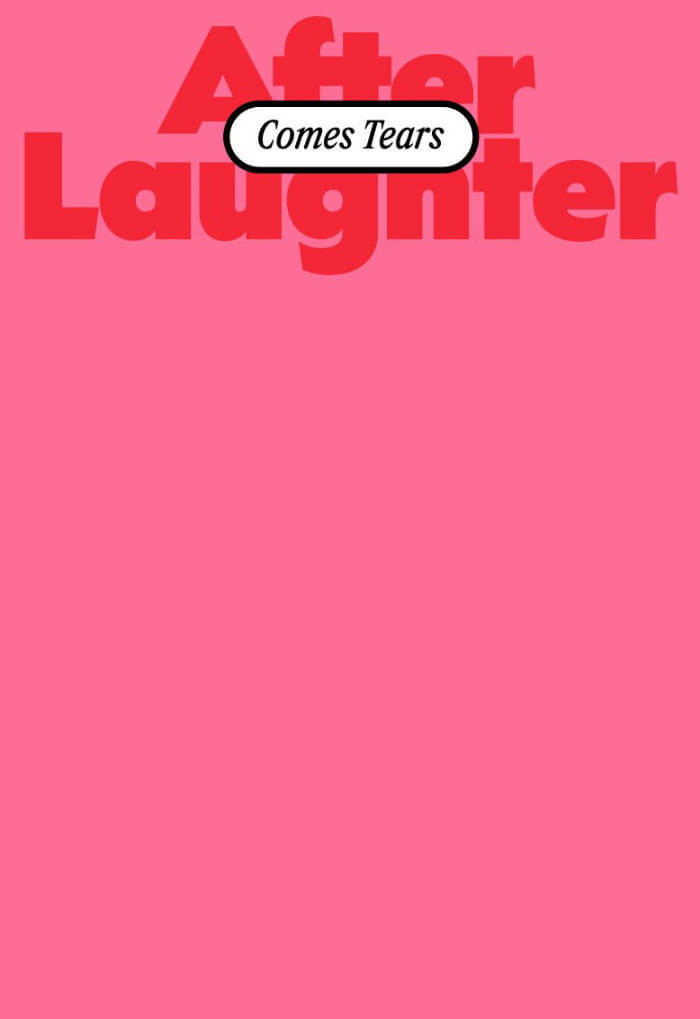
After Laughter Comes Tears
Joel Valabrega, Clementine Proby and 1 more
After Laughter Comes Tears, in its exhibition and book forms, brings together artists from different generations who are experimenting with the idea of the performative. This publication follows the structure of the exhibition at Mudam Luxembourg, with a prologue, four acts and an epilogue, which each sample excerpts from the range of theory, fiction and poetry that inspired and substantiate the themes of the exhibition. Widening the spectrum of the traditional catalogue, each artist was given a "carte blanche"—an invitation to contribute to the book on their own terms.
This performative book was conceived as a story; a story of the pains, joys, anxieties and doubts of the 2020s. It takes as a starting point, the feelings of stasis and anger that define the present stage of late capitalism, framed by the anxieties of a generation facing a climate crisis, welfare states trampled and failed by neoliberal policies and the rise of xenophobia around the globe, partly fueled by fake news spreading on- and offline. It is an intuitive journey through the voices of thirty-four artists expressing the lurid shapes of the crises that surround us and form a (never exhaustive) part of our contemporary reality.
They are Cem A., Panteha Abareshi, Monira Al Qadiri, Kate Cooper, Pauline Curnier Jardin, Jesse Darling, Stine Deja, Omer Fast, Anna Franceschini, Guan Xiao, Sidsel Meineche Hansen, Lukáš Hofmann, Christian Jankowski, Chris Korda, Ndayé Kouagou, Ghislaine Leung, Isaac Lythgoe, Taus Makhacheva, Diego Marcon, Jacopo Miliani, Marie Munk, Chalisée Naamani, Agnieszka Polska, PRICE, Jean-Charles de Quillacq, Mika Rottenberg, Julika Rudelius, Dorian Sari, Sin Wai Kin, Shinuk Suh, Martine Syms, Mungo Thomson, Cajsa von Zeipel, and Artur Żmijewski.
Edited by Clarisse Fahrtmann, Clementine Proby, Joel Valabrega.
Foreword by Bettina Steinbrügge.
Contributions by Kate Cooper, Lukas Hofmann, David McDermott, Markus Pilgram, Agnieszka Polska, Clémentine Proby, Sin Wai Kin, Bettina Steinbrügge, Geraldine Tedder, Joel Valabrega, Lauren Wetmore.

Feet of Clay
Curator, art historian, writer Chus Martínez and writer and curator Filipa Ramos bring together a group of artists who have been using clay, pottery and ceramics to imagine, project and shape the world they live in.
Some may associate clay, pottery and ceramics to tradition, and tradition to the past. Some may associate technology, digital communication and data with the new, and the new with the future. What if the future is only a technology as old and unusual as clay? What if clay is a matter that renews itself constantly and gives time its unpredictable configurations?
What if clay is the future and the future is clay? And if the feet of clay only reveal a vulnerability because the rest of the body is made of a different material? And if the feet of clay are actually rooting people to the earth, connecting them through the same matter? And if feet of clay are a way to establish a post-technological communication that requires no webs, no networks, no cables; only our many, one, two, eight, twenty feet and some clay?
These are some of the questions and enigmas addressed by curators Chus Martínez and Filipa Ramos, who brought together a group of artists who have been using clay, pottery and ceramics in an exhibition entitled Feet of Clay, presented at Galeria Municipal do Porto in 2021. Like clay, the project has now been moulded into book format, bringing together exclusive texts and interviews with the participating artists: Neïl Beloufa, Isabel Carvalho, Gabriel Chaile, Pauline Curnier Jardin, Formabesta (Salvador and Juan Cidrás), Tamara Henderson, Ana Jotta and Eduardo Navarro.
Texts by Neïl Beloufa, Isabel Carvalho, Gabriel Chaile, Pauline Curnier Jardin, Formabesta (Salvador e Juan Cidrás), Tamara Henderson, Ana Jotta, Chus Martínez, Eduardo Navarro, Filipa Ramos.

Dreams of a Dreamless Night
The publication is the first institutional monograph on the multimedia practice of artist and director Ali Cherri. It aims to highlight the constellation of ideas, themes, and formal concerns running through his most recent, highly significant projects.
Edited by Alessandro Rabottini and Leonardo Bigazzi, with Bianca Stoppani, this book provides an overview of the artist's output over the past three years, teasing out both new strands for interpretation and formal links between his films, videos, sculptures, drawings, and installations.
Texts by: Cecilia Alemani, Erika Balsom, Étienne Bernard, Leonardo Bigazzi, Ali Cherri, Lorenzo Giusti, Stefanie Hessler, Priyesh Mistry, Alessandro Rabottini, Stefan Tarnowski.
Video and visual artist Ali Cherri (born 1976 in Beirut, lives and works in Paris and Beirut) received a BA in graphic design from the American University in Beirut in 2000, and an MA in performing arts from DasArts, Amsterdam, in 2005. His current project looks at the place of the archaeological object in the construction of historical narratives.

Hardscapes / Here
Hardscapes / Here documents and brings together two exhibition projects by artists Nina Canell and Maria Hassabi. Produced on the occasion of the exhibitions of the same name curated by Samuele Piazza at the OGR Torino, the publication consists of two graphically specular books that merge into a single volume. Essays, unpublished materials and a rich set of photographic materials form the driving force behind two visual narratives that offer new keys to understanding the research of the two artists.
Hassabi's live installation Here calls on visitors to share space and spend time with six performers portrayed in a decelerated rhythmic choreography within a sculptural environment. In constant motion, the dancers contribute to a situation of shifting presence, demonstrating the contestable nature of the "here and now." Immobility and slowing down are thus used both as techniques and as subjects of representation: the performing bodies oscillate between dance and sculpture, subject and object, living body and static image.
Canell's Hardscapes combines two works that focus on the concepts of circulation and transformation as well as on unexpected forms of coexistence. Energy Budget (2017–18), a video that alternates between two subjects: a basement in which a leopard snail crawls over an electrical panel, and the gradual shifting of the frame away from "dragon gates"—portal-like openings in huge buildings on the Hong Kong waterfront. Muscle Memory (16 Tonnes) (2020–21) is a floor sculpture, decomposed and transformed by the density of moving bodies, which literally crumbles under the soles of passing visitors.
In addition to texts by the curator, the publication includes essays by Felicia Leu and Laura Preston, along with a conversation by Maria Hassabi and Nina Canell with Lorenzo Giusti.
Published on the occasion of the epoymous exhibitions at OGR Torino in 2022.
Edited by Samuele Piazza.
Texts by Lorenzo Giusti, Felicia F. Leu, Samuele Piazza, Laura Preston.

Remembering a Dance – Part of Some Sextets 1965/2019
A re-examination of Yvonne Rainer's Parts of Some Sextets, a radical performance and pivotal piece in the American choreographer's career, which led her to theorize her conception of dance in the 1960s, before being revived in 2019.
Parts of Some Sextets, Yvonne Rainer's 1965 performance for ten people and twelve mattresses, represents a turning point in the American choreographer's oeuvre. "My mattress monster," as Rainer calls it, was built in her formative years with the experimental downtown New York group Judson Dance Theater. In this work, she asserted her exploration of "ordinary" actions as well as her disregard for narrative constructions to create an intricate choreography that unfolded with a new scene every thirty seconds.
More than half a century after its premiere, Rainer, in collaboration with choreographer and dancer Emily Coates, directed the 2019 revival of the piece for the Performa 19 Biennial in New York, grappling with the changing contexts of a new presentation of her radical performance. Remembering a Dance: Parts of Some Sextets, 1965/2019 delves into every aspect of this dance, from its original manifestation to its reconstitution.
This book, designed by visual artist Nick Mauss, includes previously unpublished archival images and documents from the 1965 stagings at the Judson Memorial Church in New York and the Wadsworth Atheneum in Hartford, Connecticut. Texts by Emily Coates, RoseLee Goldberg, Jill Johnston, Kathy Noble, Yvonne Rainer, David Thomson, Lynne Tillman, and Soyoung Yoon, as well as a new interview with Rainer, pose questions about the trajectories of artworks, performers, and audiences, all while tracing the life—and afterlife—of a dance.
Edited by Emily Coates.
Texts and contributions by Emily Coates, RoseLee Goldberg, Jill Johnston, Kathy Noble, Yvonne Rainer, David Thomson, Lynne Tillman and Soyoung Yoon; conversation between Yvonne Rainer, Emily Coates and Nick Mauss.
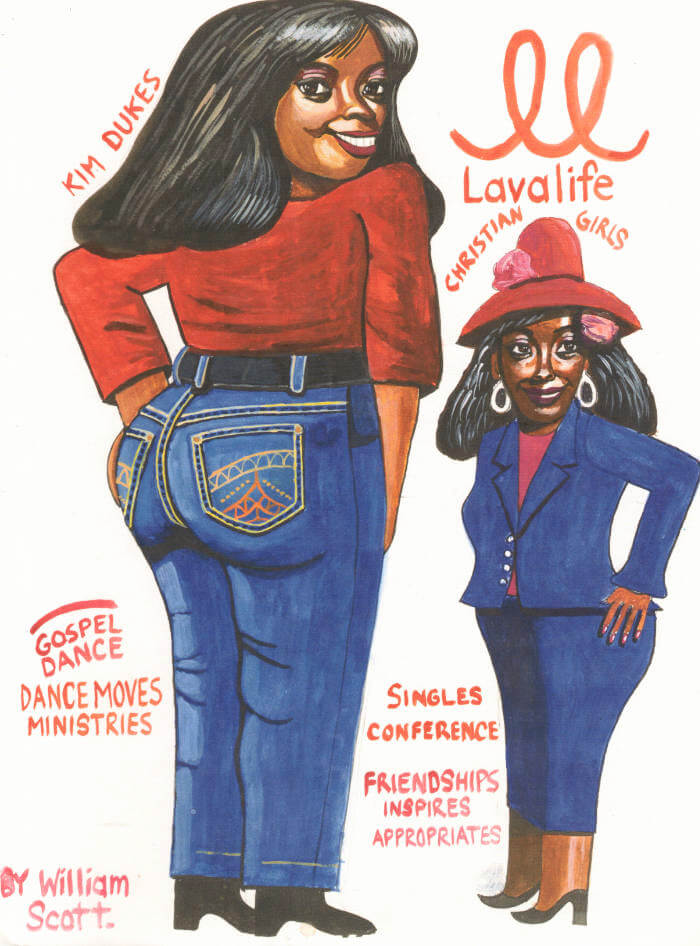
William Scott
Covering the past thirty years of William Scott's practice, this monograph offers the largest comprehensive selection of paintings, drawings, masks and architectural models, as well as an unique insight on his creative and transformative approach.
Published on the occasion of Malmö Konsthall William Scott's exhibition at Mälmo Konsthall en 2022.
William Scott (born 1962 in San Francisco) has developed his own artistic practice while working at Creative Growth, an art center in Oakland where people with development disabilities are given the opportunity to work and advance creatively as artists. Combining image and text, his colourful paintings tie in stylistically with current popular culture. Scott's vividly graphic and highly detailed paintings, drawings, and sculptures explore the intersections of community, cultural memory, faith, and science fiction. "Rebirth" is a constant subject for the artist, who reimagines the social topography of his native San Francisco as well as new, interstellar organizations. His portraits depict family members and neighbors, and celebrate Black actors, musicians, and civil rights leaders. For Scott, painting is a transformative as well as a documentary tool; a way to re-craft his personal narrative and even undertake extraordinary acts.
Edited by Nicola Wright
Texts by Carson Cole Arthur, Nana Biamah-Ofosu, Helen Delaney, Tom di Maria, Simona Dumitriu, Nathan Hamelberg, Kathleen Henderson, Matthew Higgs, William Scott, Nicola Wright

Emmy Hennings / Sitara Abuzar Ghaznawi
Emmy Hennings, Sitara Abuzar Ghaznawi
As a cofounder of Cabaret Voltaire in 1916, Emmy Hennings, with her partner, the Dadaist Hugo Ball, is recognized as having established and environment for collective experimentation. This book gathers an extensive collection of Hennings's writings, ephemera, and art, to give shape to a practice and an individual so ofter flattened for the sake of art historical narrative.
In the exhibitions held at Cabaret Voltaire and at the Swiss Institute in 2020, Sitara Abuzar Ghaznawi made evocative displays that created space for a deeper engagement with Hennings's life and art. For this publication, she has made new collages, combining found materials and working tools suck as adhesive strips, supplemented by graphic gestures and subjective indexes such as cigarette butts. By bringing the Hennings archive into dialogue with her own work, Ghaznawi considers the manner in which an individual's multiple identities guide the accumulation of personal experience, be they her own or those of a woman she never met. Commissioned on the occasion of her exhibitions, and published together here for the first time, are texts by Ghaznawi's friends and collaborators Michael Zimmerman, Samuel Lala, Nils Amadeus Lange, Sophia Rohwetter, Der Serpas, Olamiju Fajemisin, Samiran Istifan, Timur Akhmetov and Furqat Palvan-Zade.
Published following the exhibitions Emmy Hennings / Sitara Abuzar Ghaznawi at Cabaret Voltaire, Zurich, and the Swiss Institute, New York, in 2020-2021.
Emmy Hennings (1885–1948) was a writer, actress, cabaret artist and co-founder of the artists' bar with Hugo Ball, and probably the most present figure at Cabaret Voltaire. The fact that she received little attention as a writer and artist may be due to various reasons. Perhaps it was the distinct language, or the general uneasiness at dealing with her Catholicism; whatever it was, her trace is missing in the male-dominated Dada historicisation. Only recently has Hennings received recognition, and indeed beyond the role of cabaret star. Whoever reads her novels, poems, and reviews will encounter a woman for whom writing was a survival strategy. She astutely analyses her existence and stages herself as a multiple.
Sitara Abuzar Ghaznawi (born 1995 in Ghazni, Afghanistan) lives and works in Zurich and Obwalden. Her assemblages transgress forms and space, revealing a questioning of institutional structures and accepted ideas of craft and taste. In her sculptural transformations her processes insist on maintaining the visibility of the lowly beginnings of her materials, forming strong, shameless and rigorous poetries.
Edited by Simon Castets and Salome Hohl.
Texts by Salome Hohl, Laura McLean-Ferris, Michael Zimmerman, Samuel Lala, Nils Amadeus Lange, Sophia Rohwetter, Der Serpas, Olamiju Fajemisin, Samiran Istifan, Timur Akhmetov, Furqat Palvan-Zade.
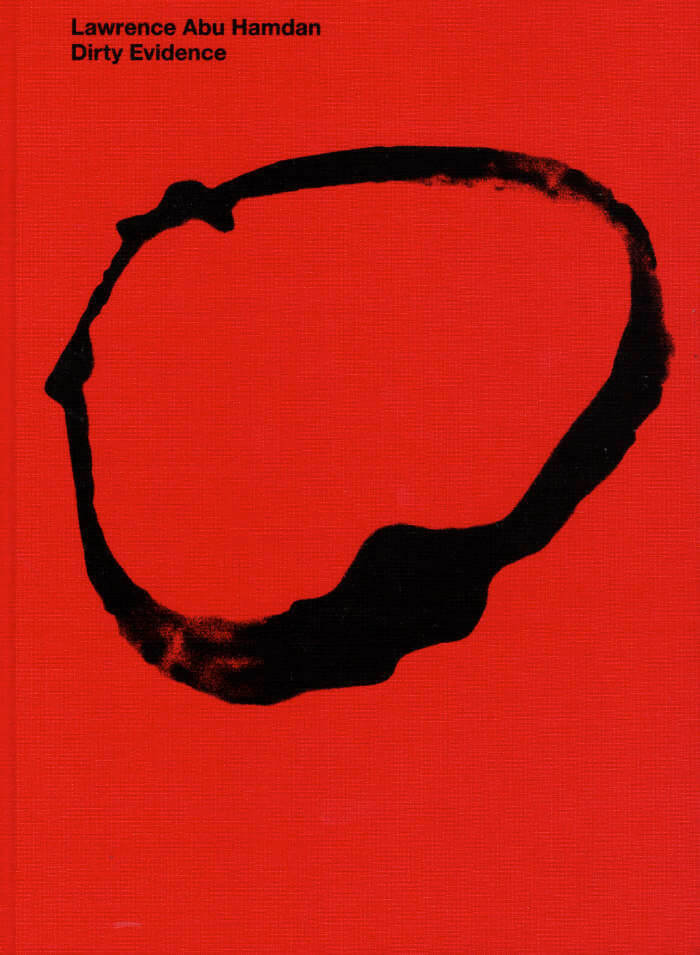
Dirty Evidence
Richly illustrated, this book provides for the first time a visual overview of Lawrence Abu Hamdan's works of more than a decade, and elaborates on a formal vocabulary characterized by the aesthetics of sound and language.
On the occasion of Lawrence Abu Hamdan's exhibition at Bonniers Konsthall in Stockholm in 2021, a group of authors have been invited to engage with individual works and their underlying concepts. Abu Hamdan recognizes the space for art as a site where attention can be drawn to real socio-political conditions in order to challenge the structures behind them. The artist can therefore push at the boundaries of what constitutes testimony. The title "Dirty Evidence" comes from Abu Hamdan's definition of evidence in which a truth value is derived from its very inadmissibility before the law. It is precisely the evidence's figurative dirt and dirtiness that works toward the production of truth.
Lawrence Abu Hamdan (born 1985 in Amman, Jordan, lives and works in Beirut, Lebanon) is an artist and “private ear” whose projects have taken the form of audiovisual installations, performances, graphic works, photography, Islamic sermons, cassette tape compositions, potato chip packets, essays, and lectures. Abu Hamdan's interest with sound and its intersection with politics originate from his background in DIY music.
Edited by Fabian Schöneich.
Graphic design: David Bennewith.
Texts by Lawrence Abu Hamdan, Natasha Ginwala, Ruba Katrib, Andrea Lissoni, Ramona Naddaff, Fabian Schöneich, Yasmine Seale, Theodor Ringborg, Eyal Weizman.
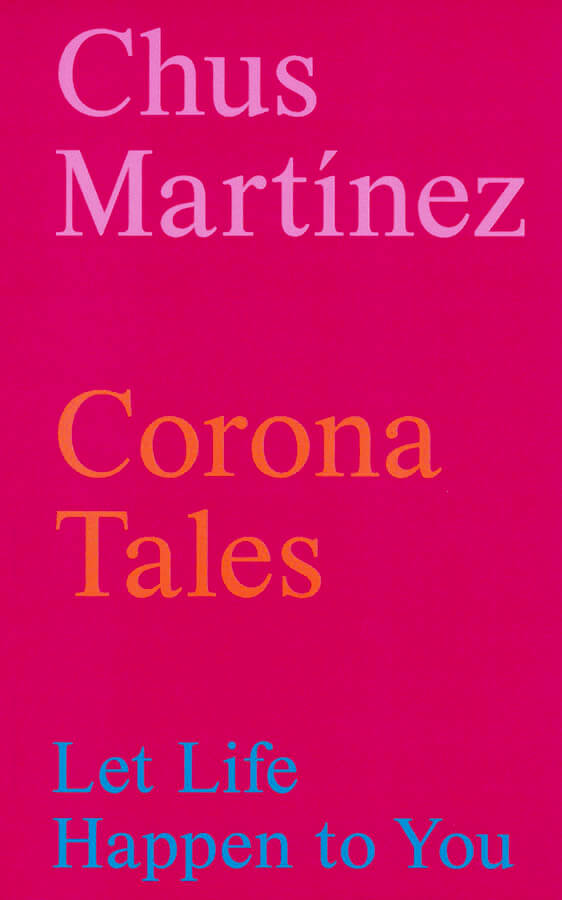
Corona Tales – Let Life Happen to You
When she started writing the Corona Tales, Chus Martínez had been weighing how people and the media were addressing the outbreak of the virus as an unprecedented disaster. One possible contribution, as curator and writer, would be to write a short story a day and post it on an Instagram account that many could access…
Martínez grew up with her grandparents till she was four, and so did her cousin, while both their parents migrated to a big city—hers to Barcelona, his to Basel—to work. The grandparents' childhood was marked by extreme poverty: the Spanish flu left the grandfather orphan of both parents; the grandmother's family, from the same small village in the north west coast of Spain, was also forced to encourage their children to help and work for money. These circumstances were reflected by them—with no trace of sorrow or bitterness.
The recovery was so slow that the author's mother could not afford to attend school and it was only when she married that she and her father enrolled a night course. The stories about these two generations, posted daily, from Basel, around 7pm, offered a chance for gathering, if just virtually, demanding to identify vulnerabilities, how the COVID-19 crisis was being generalized, and how to research ways of doing. Accompanied for the first time in this book by new imagery, they provide tools for reflecting in the past and present tense.
Published December 2020
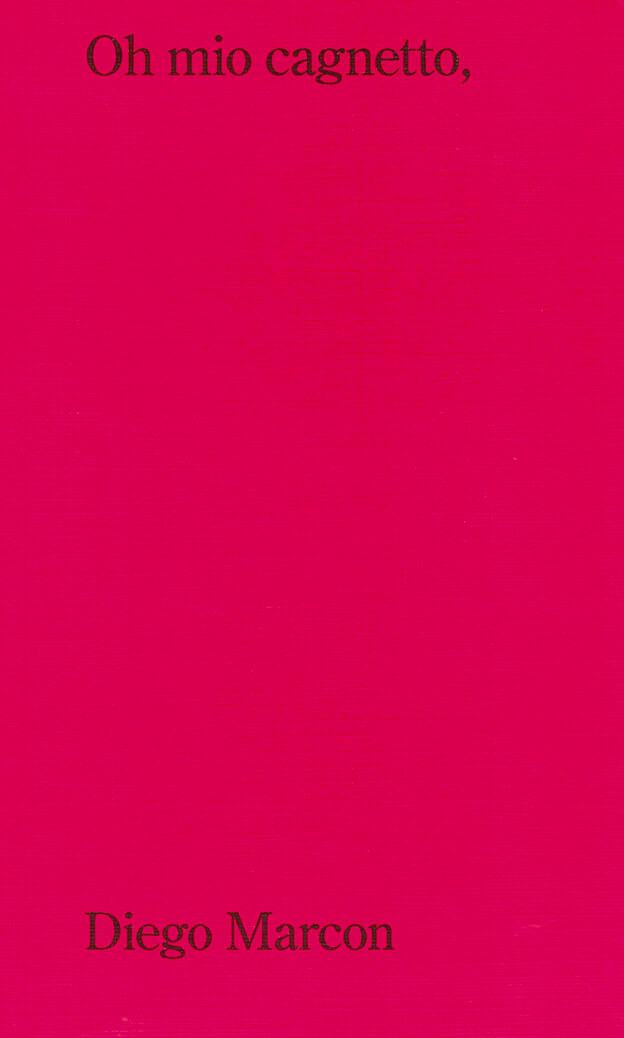
Oh mio cagnetto
Oh mio cagnetto is the artist's first book of writings, conceived as an artwork. It is a collection of 81 little poems that revolve around the missed and mourned figure of a puppy.
These short nursery rhymes all open with the same words and employ the same structure: two rhymed couplets in traditional meter. A seemingly naïve, childish voice speaks of violence, death and grief, yet never slips into pure plaintive lament. Balancing pathos with humor, the poems turn the puppy into a figure that evokes a broader sense of loss.
Oh mio cagnetto, was written between 2018 and 2020 and is now in the collection of MACRO in Rome. It intentionally plays on the ambiguity of its nature, as both a book distributed in conventional ways and an art object that belongs to a museum.
Diego Marcon (born 1985 in Busto Arsizio, Italy, lives and works in Paris) is a visual artist working mostly with film and video.